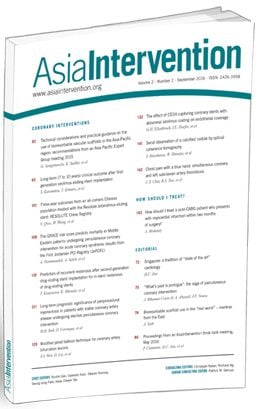Clinical outcomes of percutaneous coronary intervention (PCI) have been improving due to evolutions such as development of new-generation drug-eluting stents, use of intracoronary imaging device and widespread use of optimal medical therapy1.
Nevertheless, current PCI has not achieved outcomes comparable to coronary artery bypass grafting (CABG)2,3, especially in patients with complex lesions such as heavily calcified lesions. Rotational atherectomy (RA) is one of the important options for heavily calcified lesions in PCI. However, the clinical adverse event rate in PCI requiring RA has been high in real-world practice4. To improve clinical outcomes of PCI requiring RA, some important procedural points should be addressed. First, avoiding life-threatening complications such as coronary perforation should be the bottom-line requirement for the appropriate practice. Second, procedural management for preventing large periprocedural myocardial injury would be essential. Previous reports have suggested that large periprocedural myocardial infarctions were associated with a substantial increase in subsequent mortality5. Third, adequate ablation for optimal stent expansion is important. It has been reported that optimal stent expansion was associated with better clinical outcomes6,7,8.
The European expert consensus suggests that the safe range of speed in rotablation is between 135,000 and 180,000 rpm, because it has been reported that a speed lower than 135,000 rpm might be associated with burr lodging, while a speed higher than 180,000 rpm might increase platelet activation and thrombotic complications9,10,11. However, in a previous randomised controlled trial comparing low-speed RA (LS-RA: 140,000 rpm) versus high-speed RA (HS-RA: 190,000 rpm), the incidence of slow flow was not significantly different12. An appropriate strategy for ablation speed still has not been established. In this issue of the Journal, Yoshida et al report an interesting technique with LS-RA (115.000 rpm) following HS-RA (200,000 rpm)13.
This study demonstrates that additional LS-RA following HS-RA ablated more plaque volume and gained a larger minimum lumen area compared with HS-RA only. There was no lodging of the burr, and slow flow occurred in five patients (18.5%). Step-by-step ablation might be an important point for a safe and effective procedure. Cost-effectiveness might also be an important point. However, this is a small retrospective study. The efficacy and safety of this novel technique should be evaluated by larger randomised controlled trials. The establishment of an appropriate strategy for heavy calcification is essential for PCI evolution towards a complete alternative to CABG.
